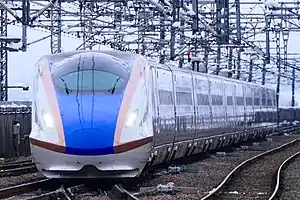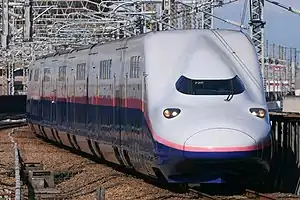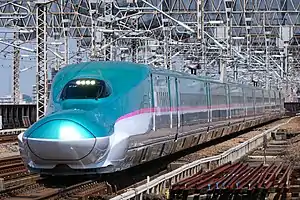 An E7 series on a Toki service in January 2021 | |
| Overview | |
|---|---|
| Service type | Shinkansen |
| Status | Operational |
| Locale | Honshu, Japan |
| First service | 10 June 1962 (Limited express) 15 November 1982 (Shinkansen) |
| Current operator(s) | JR East |
| Former operator(s) | JNR |
| Route | |
| Termini | Tokyo Niigata |
| Line(s) used | Joetsu Shinkansen |
| On-board services | |
| Class(es) | Standard + Green + Gran Class |
| Catering facilities | Trolley service |
| Technical | |
| Rolling stock | E7 series |
| Track gauge | 1,435 mm (4 ft 8+1⁄2 in) |
| Electrification | 25 kV AC (50 Hz), overhead |
| Operating speed | 275 km/h (170 mph) |
The Toki (とき) is a high-speed Shinkansen train service operated by East Japan Railway Company (JR East) on the Joetsu Shinkansen in Japan.[1]
The name is taken from the Japanese name of the crested ibis, for which Niigata is famous.
Station Stops
- Tokyo
- Ueno*
- Ōmiya
- Kumagaya*
- Honjo-Waseda*
- Takasaki*
- Jomo-Kogen*
- Echigo-Yuzawa*
- Urasa*
- Nagaoka*
- Tsubame-Sanjo*
- Niigata
(*) Not served by all trains
Rolling stock
- E7 series 12-car sets (Toki) (from 3 March 2019)
 An E7 series set
An E7 series set
Former rolling stock
- E1 series 12-car sets (Max Toki) (until 28 September 2012)
- 200 series 10-car sets "K" sets (until 15 March 2013)
- E2 series 10-car sets (from 26 January 2013)[2]
- E4 series 8-car sets (Max Toki) (until 1 October 2021)
.jpg.webp) A refurbished E1 series set
A refurbished E1 series set A refurbished 200 series set
A refurbished 200 series set An E2 series trainset
An E2 series trainset A refurbished E4 series set
A refurbished E4 series set
History
Limited express

The name Toki was first introduced on 10 June 1962 for limited express services operating between Ueno in Tokyo and Niigata on the Joetsu Line. This service operated until 14 November 1982, the day before the Joetsu Shinkansen opened.[3]
Shinkansen
From the start of services on the newly opened Jōetsu Shinkansen on 15 November 1982, Toki became the name used for the all-stations shinkansen services operating initially between Ōmiya and Niigata, later between Ueno and Niigata, and eventually between Tokyo and Niigata.[3]
The Toki name was discontinued from October 1997 following the introduction of new Tanigawa all-stations services between Tokyo and Echigo-Yuzawa. However, the name was reinstated from December 2002 to replace the name Asahi used for all Tokyo to Niigata trains.[1]
E2 series 10-car sets were re-introduced on four return Toki services daily from 26 January 2013, operating at a maximum speed of 240 km/h (150 mph).[2][4]
The E4 series sets were retired at the beginning of October 2021, marking the end of bi-level high-speed trains operating on Shinkansen services.[5]
E2 series sets were removed from all Toki services (as well as the slower Tanigawa services on the Joetsu Shinkansen) on 18 March 2023 timetable revision as the line underwent an operating speed increase from 240 to 275 km/h (149 to 171 mph).[6]
Special train services
A special Joetsu Shinkansen 30th Anniversary (上越新幹線開業30周年号, Jōetsu Shinkansen Kaigyō 30-shūnen-gō) service ran as Toki 395 from Omiya to Niigata on 17 November 2012 using 10-car 200 series set K47.[7]
See also
References
- 1 2 JR新幹線&特急列車ファイル [JR Shinkansen & Limited Express Train File]. Japan: Kotsu Shimbun. 2008. ISBN 978-4-330-00608-6.
- 1 2 上越新幹線でE2系の定期運用再開 [E2 series returns to regular duties on Joetsu Shinkansen]. Japan Railfan Magazine Online (in Japanese). Japan: Koyusha Co., Ltd. 27 January 2013. Archived from the original on 23 October 2017. Retrieved 23 October 2017.
- 1 2 列車名鑑1995 [Train Name Directory 1995]. Japan: Railway Journal. August 1995.
- ↑ E2系車両を上越新幹線に投入! [E2 series trains to be introduced on Joetsu Shinkansen] (PDF). News Release (in Japanese). Japan: East Japan Railway Company. 16 November 2012. Retrieved 16 November 2012.
- ↑ "JR East to Retire the Last Double-Decker Shinkansen Train – Japan Station".
- ↑ "JR東日本,3月18日にダイヤ改正を実施" [JR East Implements Schedule Revision Effective 18 March 2023]. Japan Railfan Magazine Online (in Japanese). 16 December 2022. Archived from the original on 19 December 2022. Retrieved 19 December 2022.
- ↑ "とき"395号「上越新幹線開業30周年記念号」運転 [Toki 395 "Joetsu Shinkansen 30th Anniversary"]. Japan Railfan Magazine Online (in Japanese). Japan: Koyusha Co., Ltd. 18 November 2012. Retrieved 18 November 2012.
External links
- 200 series Yamabiko/Toki/Nasuno/Tanigawa (in Japanese)
- E1 series Max Toki/Max Tanigawa at the Wayback Machine (archived 22 July 2011) (in Japanese)
- E4 series Max Toki/Max Tanigawa Archived 24 July 2017 at the Wayback Machine (in Japanese)



